Mom’s Classic French Bread Sage Stuffing
Vegetable-packed Sage Stuffing for Turkey is the perfect Thanksgiving and holiday side dish! This classic white bread stuffing recipe requires some prepwork days ahead (though there is a shortcut!) and bakes for less than an hour before it’s ready to devour. Bake it in the turkey or in a casserole dish.
Want to see variations on dressing? Check out Brioche Bread Stuffing Recipe and Baguette Bacon Stuffing!
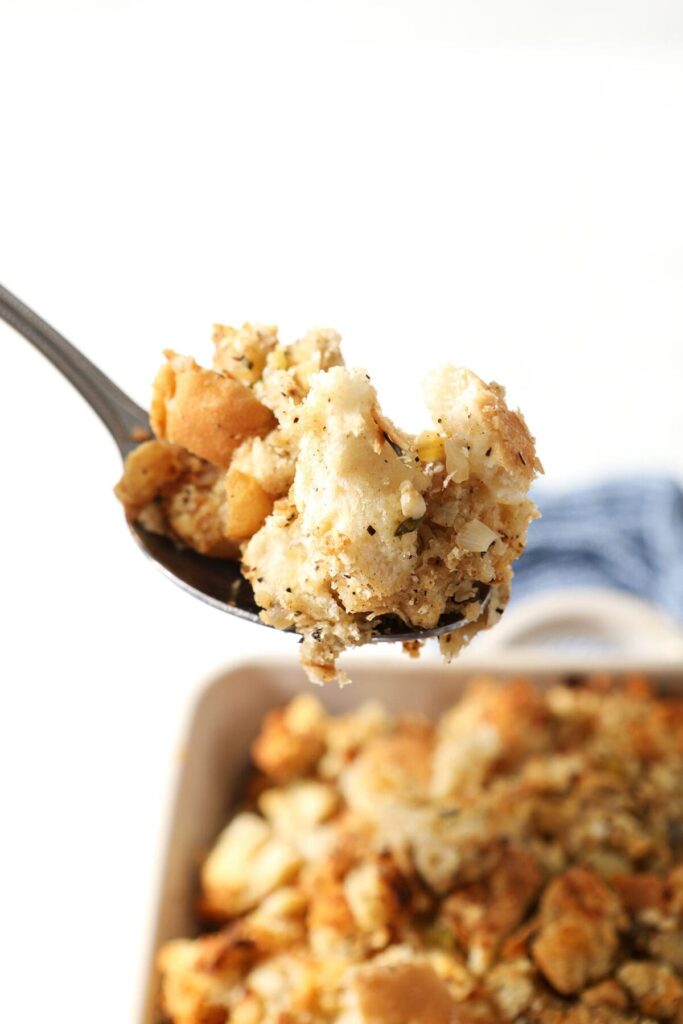
This post contains affiliate links.
What is stuffing?
Stuffing is a classic Thanksgiving and holiday dish that’s oftentimes made from bread, vegetables, herbs and spices.
There are various stuffing and dressing recipes that call for different ingredients.
Some common ones are like this, with sage and bread. Cornbread dressing or cornbread stuffing is another beloved recipe. Stovetop Sausage Stuffing is also popular.
What is difference between stuffing and dressing?
In my understanding, stuffing is cooked inside a turkey and baked. Dressing is cooked in a separate dish.
So technically, this is a Sage Dressing recipe since I didn’t stuff it into our Cajun Turkey.
My mom always cooks hers that way, though, so this can be both.
Why I love this recipe:
This Thanksgiving Stuffing recipe tastes like home and childhood.
It’s our family’s traditional recipe, and I am thrilled to be sharing it with y’all.
Last year, I followed my mom around the kitchen Thanksgiving morning and documented exactly what she did, measuring everything along the way.
This a must-have recipe at our Thanksgiving table and throughout the holiday season.
It highlights stale bakery-style bread, a ton of fresh herbs, as well as some dried herbs and spices, too. We’ve got some veggies that go into it, as well, to add more depth of flavor and texture.
The combination of all the ingredients just tastes comforting and perfect when you pair it with your favorite turkey and Thanksgiving side dishes.
Please note that this homemade stuffing recipe is also fabulous for other holidays, like Christmas and Easter.
More Thanksgiving side dishes to try: Bourbon Sweet Potato Casserole | Bacon Wrapped Green Bean Bundles | Creamed Cornbread Casserole | Homemade Mashed Potatoes | Fresh Cranberry Sauce
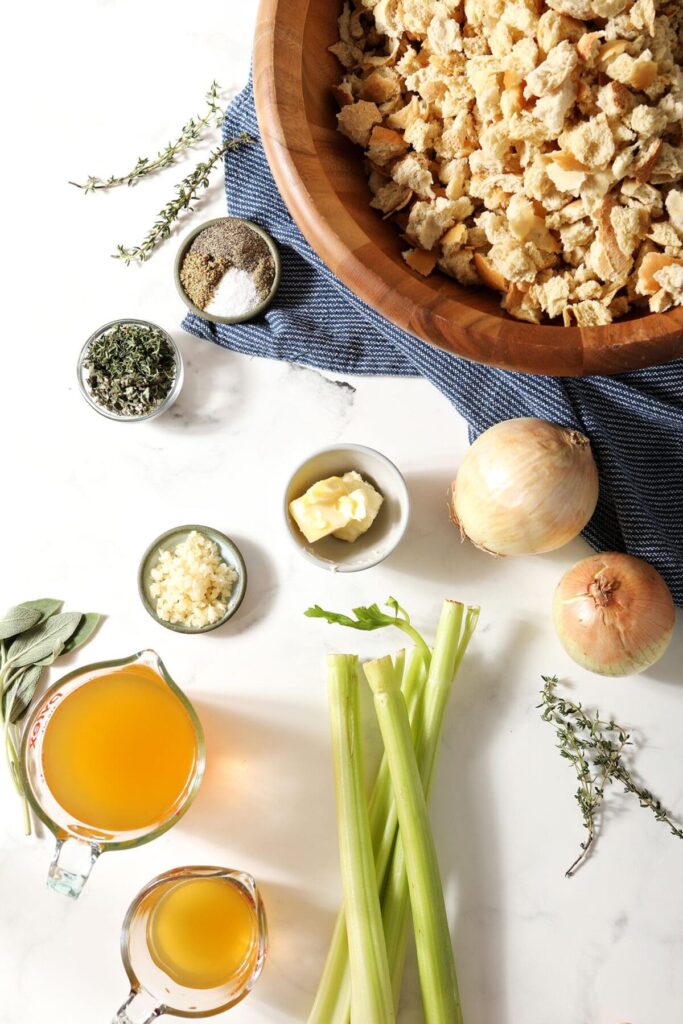
What you’ll need to make this recipe:
The Speckled Palate participates in affiliate programs. As an Amazon Associate, I earn a commission from qualifying purchases. Please refer to my disclosure page for more information about these affiliate programs.
- A serrated knife, a chef’s knife and a cutting board
- Large bowl
- Nonstick skillet
- Wooden spoon or rubber spatula
- Deep casserole dish (9”x13”, if not larger)
Let’s talk ingredients!
In addition to the tools above, you’re going to need some ingredients to make this recipe, too! Chances are, you might already have some of them in your fridge or pantry. Scroll down to the recipe card for the full measurements and instructions.
Here’s what you’ll need:
- French bread — my mom specifies that the cheap bread is OK. However, sandwich bread is not. You’ll need three loaves, or 48 oz. Stale bread is key, so purchase it days beforehand… or toast it.
- Unsalted butter — to add a little extra flavor to the veggies and herbs. You could also use salted butter and use a little less salt.
- Onions — you can use white or yellow.
- Celery — yes, celery. It adds awesome flavor and texture to the classic stuffing recipe, so please don’t skip it.
- Garlic — you’re going to need a lot of it. Feel free to purchase the pre-minced kind here or use a garlic press to take fresh garlic and break it down.
- Fresh sage — we need a lot. It usually comes in plastic clamshells, but sometimes the stores sell larger bundles. If so, use that! You can use the extra as garnish, too.
- Fresh thyme — for additional pops of flavor from fresh herbs. I hate pulling the thyme from the stems, so do that early if you can… or rope a kitchen helper in to assist you.
- Dried ground sage — this adds extra sage flavor. My mother swears by this Dalmatian sage.
- Coarse kosher salt — the texture of the salt matters here. I like to use a medium-grain kosher salt, but you could use medium-grain sea salt, too.
- Black pepper — we like to crack our own, but you can use the pre-ground stuff, too.
- Poultry seasoning — Penzey’s Mural of Flavor is my go-to poultry seasoning. I love it because there’s no added salt and it bursts with flavor. Any poultry seasoning should work, though.
- Low sodium chicken broth or stock — you can also use turkey stock or a vegetable stock.
Customizations and substitutions
If you’re serving vegetarians, you can use vegetable stock instead of chicken broth or stock to make this a vegetarian stuffing. You might need to add extra salt if you’re using this since it’s unsalted.
Use a different type of bread. While our traditional stuffing recipe calls for French bread, you could substitute the same amount of stale sourdough bread.
For the shoot day, we made this vegetarian because one of our friends does not eat meat.
Make this a dairy-free stuffing recipe with olive oil in place of the butter. The flavor will be a little bit different, but it will work just fine!
Add more herbs. Chopped fresh rosemary and parsley would add color and flavor to this already flavorful stuffing.
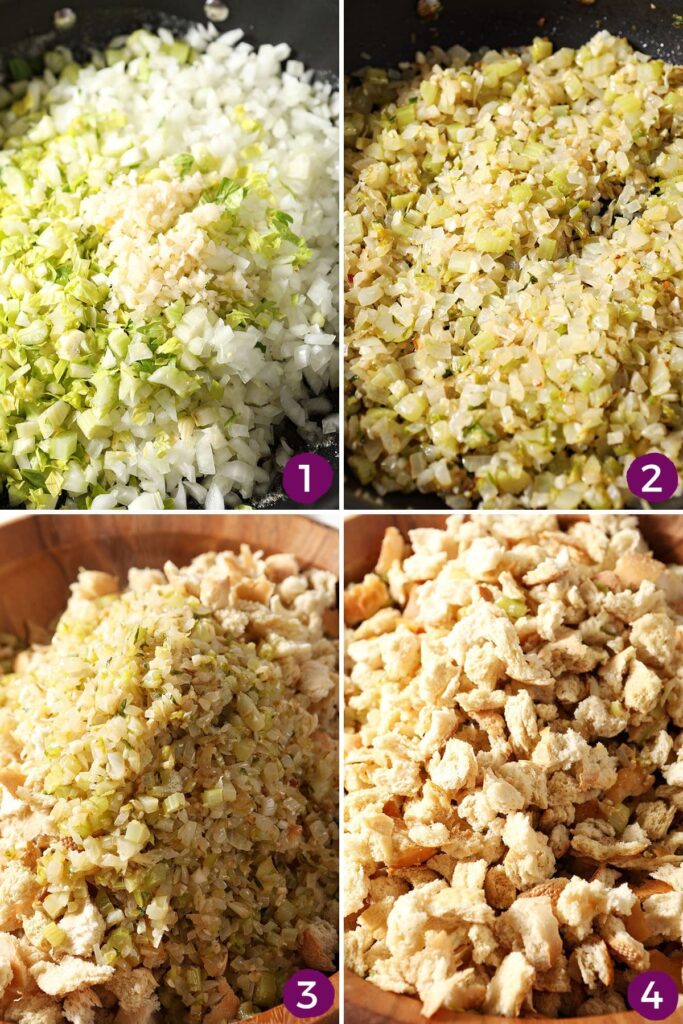
How to make Mom’s White Bread Stuffing
Prepare bread for stuffing
Two-three days before you plan to make and serve the stuffing, prepare the bread.
Chop the bread into 1” cubes or rip it into bite-sized pieces before you let it go stale.
Place in a large bowl, set aside and let sit until super stale.
If your bread is not stale when it’s the day of, warm the oven to 200°F.
Place the cubed/bite-sized bread on a rimmed baking sheet, and bake for 30-45 minutes or until crispy.
The key is you want these to be dried bread cubes before proceeding or the texture will be all wrong.
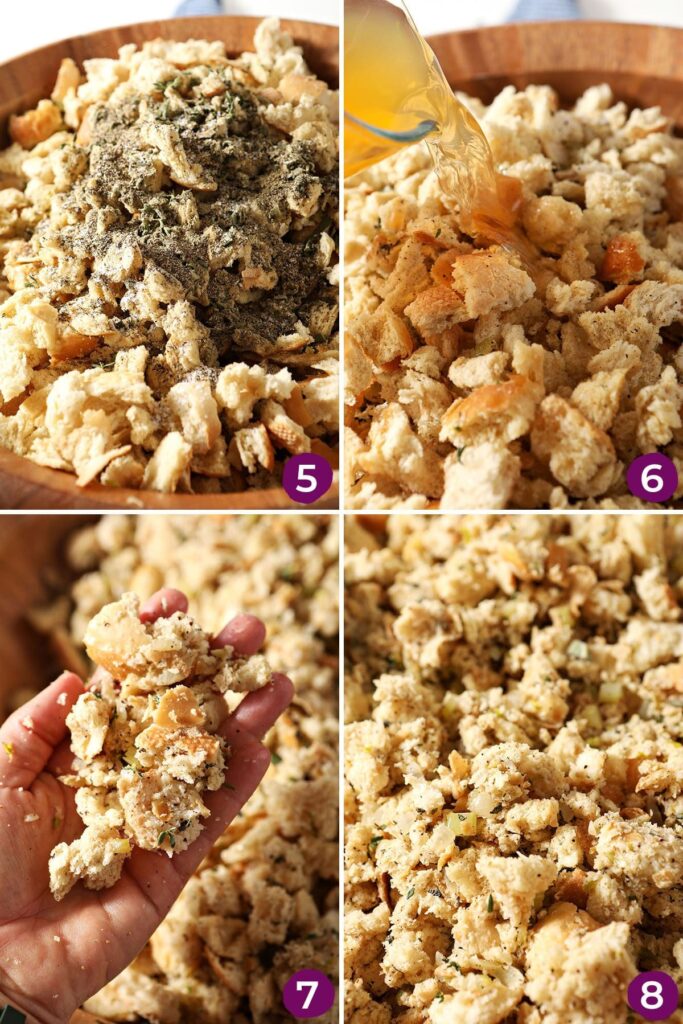
Make the Sage Stuffing
Melt the butter in a large skillet. I like to use a nonstick skillet. You could also use a large Dutch oven.
Add the chopped onions, celery and garlic to the melted butter. Cook until the vegetables have softened, about 5-8 minutes, stirring occasionally.
Remove the vegetables from the heat, and set aside to cool slightly.
Preheat the oven to 350°F. Spray a large casserole dish with nonstick baking spray, and set aside.
Did you know…
You can bake the stuffing INSIDE the cavity of the turkey, too!
If you’re planning to do this, use your hands to transfer the stuffing inside of the raw bird. (More on this in a bit.) You will probably need a casserole dish for any overflow—this stuffing recipe makes a lot, after all—but you can do it that way, too!
The bake time will change if it’s not in a casserole dish and will be determined by how long the turkey needs to be baked through. Do not stuff the turkey and let it hang out—this needs to be the last step before you put it into the oven.
Sprinkle the sauteed vegetables on top of the stale bread pieces in an extra large bowl. (I had to use the biggest salad bowl we own—it’s a lot!)
Season with the chopped sage, fresh thyme, ground sage, kosher salt, black pepper and poultry seasoning.
Use your hands or a large spoon to gently toss the ingredients together.
Slowly pour in a cup of the stock, using your hands to mix everything together. (We need more stock to make this, but start with a cup and then add the extra in slowly.)
Massage the stock into the bread mixture. Add more stock slowly, and continue to massage the mixture until it’s combined.
Pro tip!
Start slowly with the pours of the stock. If you overpour the liquid, your stuffing could become too wet, which will throw off the end texture.
If it feels a little dry, add more stock. If it feels sticky and a little squishy, you’re good to go! Go by feel—you want the ingredients to be soft and soaking in the stock, but you don’t want them to be sopping wet.
When the stuffing has been put together, transfer it to the prepared baking dish and cover with aluminum foil.
Bake in the preheated oven for 30-40 minutes.
Remove the cover, and bake for an additional 20 minutes.
When browned on top, remove from the oven, and enjoy warm!
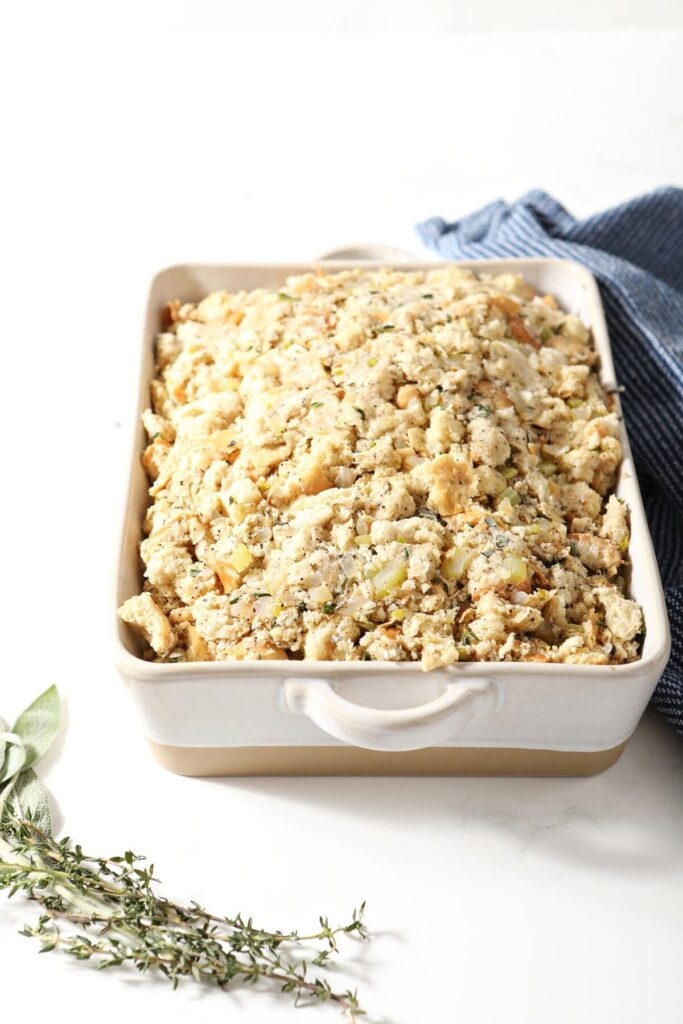
Stuffing and Dressing 101
When to make stuffing:
I like to make mine the same day I plan to eat it.
However, you can saute the vegetables 2-3 days before. Store them in the fridge. Combine them with the bread, herbs and seasonings the day of.
How to serve stuffing:
We always bake ours in a large casserole dish. You can (and should!) serve it in whatever you bake it in.
If you’re stuffing the Sage Stuffing into the turkey, remove it from the bird before carving and place in a casserole or serving dish.
How to Store and Reheat:
The beauty in stuffing like this is it will keep for 4-5 days in the refrigerator. Once it has cooled, transfer it to an airtight food storage container or cover the casserole with plastic wrap. Transfer to the fridge.
To reheat stuffing, place the amount you’d like to enjoy on a microwave-safe plate. Warm in the microwave until it reaches your desired temperature.
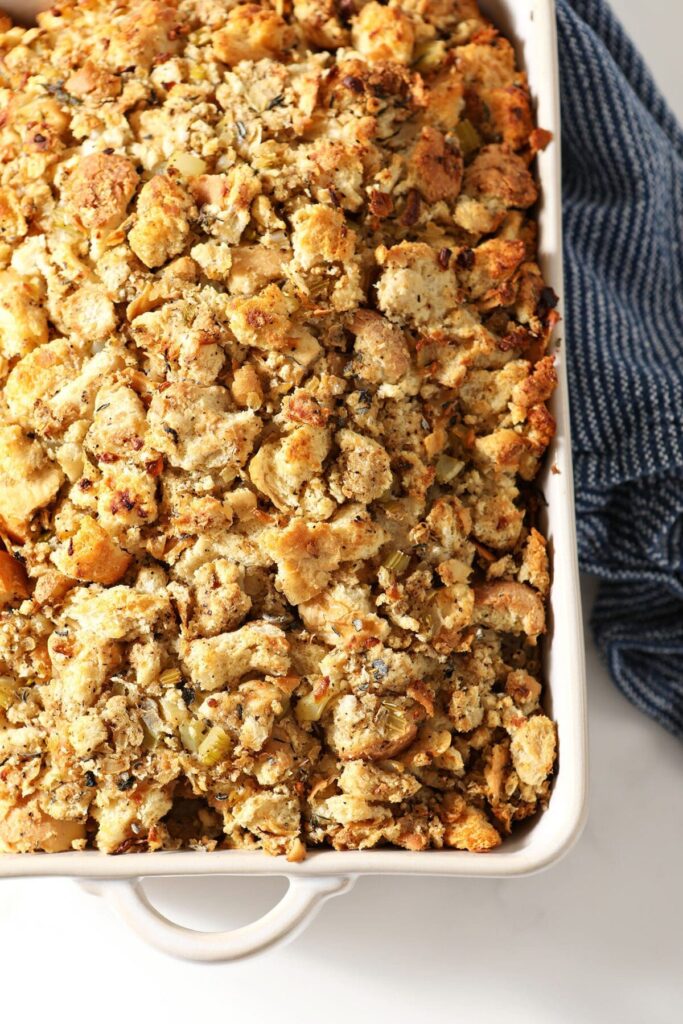
Frequently Asked Questions
I think that depends on who you ask, but traditional stuffing, to me, includes white bread (like French or Italian bread), onion, celery, a ton of sage, stock and more.
Yes! We use a combination of fresh sage, which we chop finely, and rubbed sage, in this stuffing recipe.
No! You can make and serve stuffing with a savory flavor at any holiday.
No. We do not add eggs to this recipe. It should hold together without them.
We like to use a combination of fresh and dried sage to really bring the flavors in.
We like to use Italian or French loaves, but honestly, any bread that is crusty is good for here. Baguettes are also excellent.
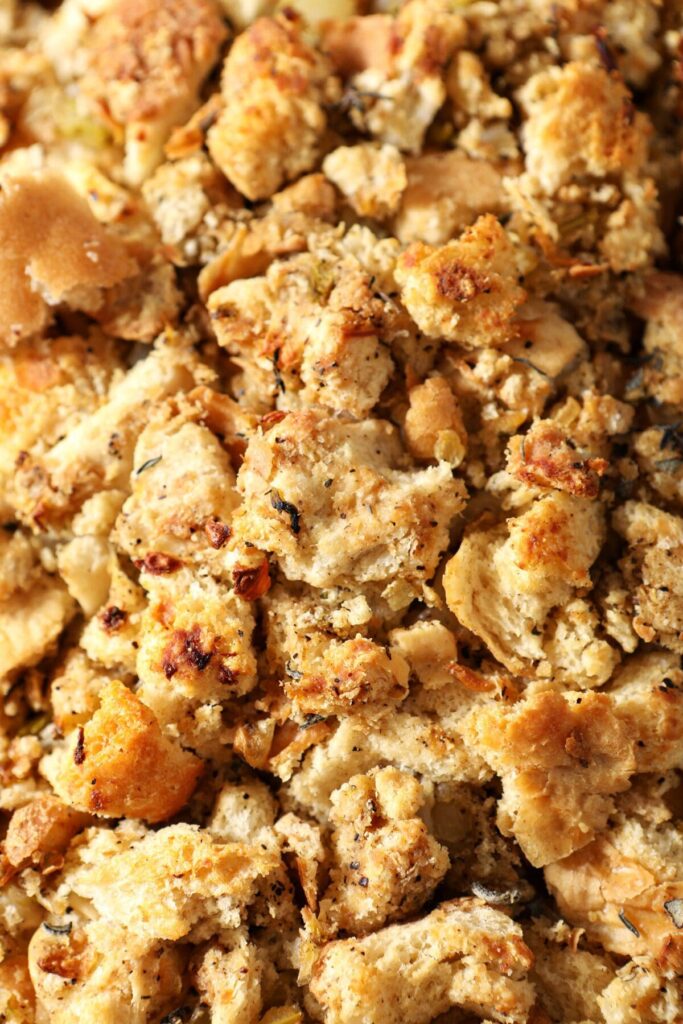
Quick tips and tricks for making the best Sage Stuffing recipe for turkey
- Make sure the bread is stale. My family tears up the bread 2-3 days in advance and lets it sit on the counter because it will go stale. If your bread is still soft, place it on a baking sheet and bake in a 200°F oven for 30-45 minutes, or until the bread is nice and crisp.
- Use your favorite loaf. My mother recommends using the cheap Italian loaves from the grocery store, but you can use any loaf that’ll get stale!
- Prep your ingredients (chop, measure, etc.) before. This’ll make it easier for you to make the stuffing.
- Not into prepping? Purchase pre-chopped vegetables to make prepwork easier.
- Saute the veggies (and season them) 1-2 days in advance. This is a way to get a leg up to where all you have to do the day of your meal is throw together the sautéed veggies and bread, then add the stock and bake ‘em.
- Pour the stock in small batches into the bread mixture. Start with a small amount so you don’t overpour and make your stuffing mushy. (How do I know this? Because I’ve done it myself.)
What to make with leftover stuffing
Got leftover stuffing? Excellent!
Here are a few ideas for what to do with it.
- Make a leftovers sandwich with all your extra Thanksgiving dishes.
- Leftovers Tacos are one of our favorite unique ways to enjoy Thanksgiving extras.
- Reheat it alongside your favorite holiday dishes, like Herb Butter Turkey Breast, Drunken Cranberry Sauce, Fresh Green Bean Casserole from Scratch and more!
Here’s how you can make this…
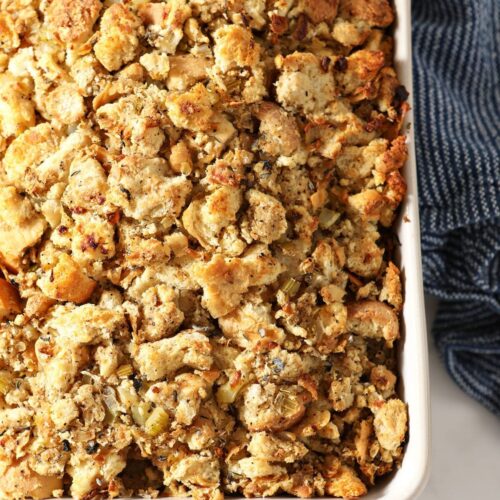
Mom’s Classic French Bread Sage Stuffing
Ingredients
- 3 loaves French bread 48 oz.
- 3 tablespoons unsalted butter
- 2 medium onions 2 cups diced
- 4 celery stalks 2 ½ cups chopped
- 6 teaspoons minced garlic
- 2 tablespoons chopped fresh sage
- 4 teaspoons fresh thyme
- 2 teaspoons dried ground sage
- 2 teaspoons coarse kosher salt
- 1 tablespoon black pepper
- 1 teaspoon poultry seasoning
- 2 ½ cups low sodium chicken stock*
Equipment
As an Amazon Associate and member of other affiliate programs, I earn from qualifying purchases.
Instructions
Prepare the bread
- Two-three days before: Chop the bread into 1” cubes or rip it into bite-sized pieces to let it go stale. Place in a large bowl, and set aside. Let sit until super stale.
- If your bread is not stale before it’s time to make the stuffing, warm the oven to 200°F and bake the cubed/bite-sized bread for 30-45 minutes or until crusty and crisp.
Make the Stuffing
- Melt the butter in a large skillet.
- Add the chopped onions, celery and garlic to the melted butter. Cook until the vegetables have softened, about 5-8 minutes.
- Remove the vegetables from the heat, and set aside to cool slightly.
- Preheat the oven to 350°F. Spray a large casserole dish with nonstick baking spray, and set aside.
- Sprinkle the sauteed vegetables on top of the stale bread pieces.
- Season with the chopped sage, fresh thyme, ground sage, kosher salt, black pepper and poultry seasoning.
- Use your hands or a large spoon to gently toss the ingredients together until combined.
- Slowly pour in a cup of the stock, using your hands to mix everything together.
- Massage the stock into the bread and vegetables, and slowly continue to do this until the mixture is combined. If it feels a little dry, add more stock. If it feels sticky and a little squishy, you're good to go! Go by feel—you want the ingredients to be soft and soaking in the stock, but you don't want them to be sopping wet.
- When the stuffing has been assembled, transfer it to the prepared baking dish and cover with aluminum foil. (Alternately, you could stuff it into the raw turkey cavity and bake it inside the bird. You will probably still need a casserole dish for the extra stuffing to bake inside.)
- Bake in the preheated oven for 30-40 minutes.
- Remove the cover, and bake for an additional 20 minutes.
- When browned on top, remove from the oven, and enjoy warm!
Video
Notes
Nutrition

About the Author:
Erin Parker is a Southern gal living in Texas with her husband and two daughters. She started The Speckled Palate to share what she was cooking as a newlywed… and over the years, it’s evolved to capture her love for hosting. Specifically, the EASIEST, lowest key entertaining because everyone deserves to see their people and connect over good food. Learn more about her…

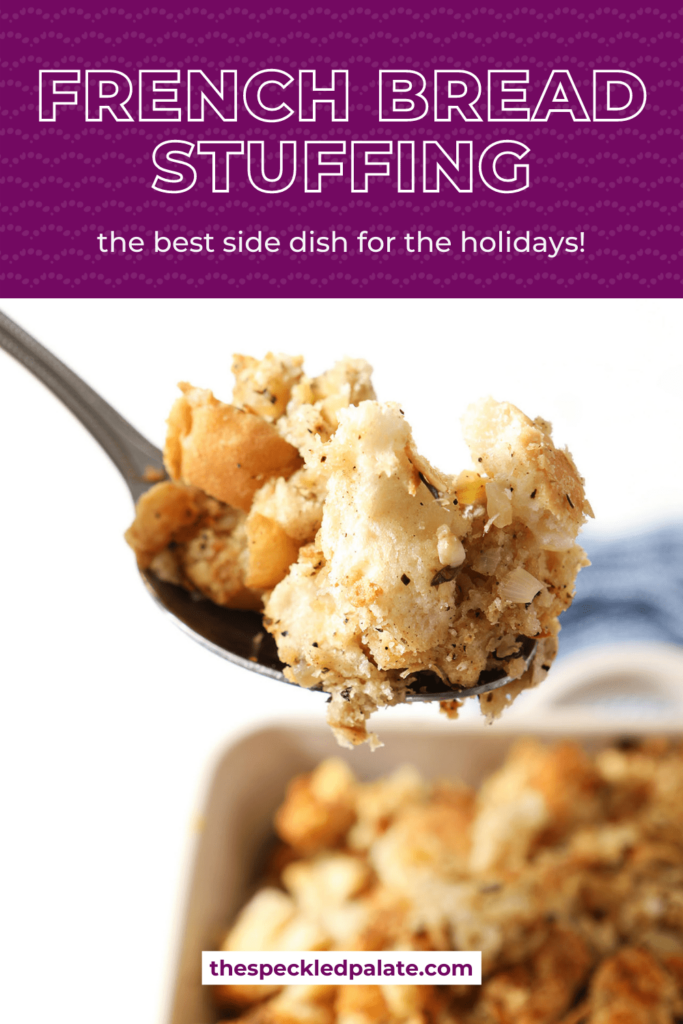
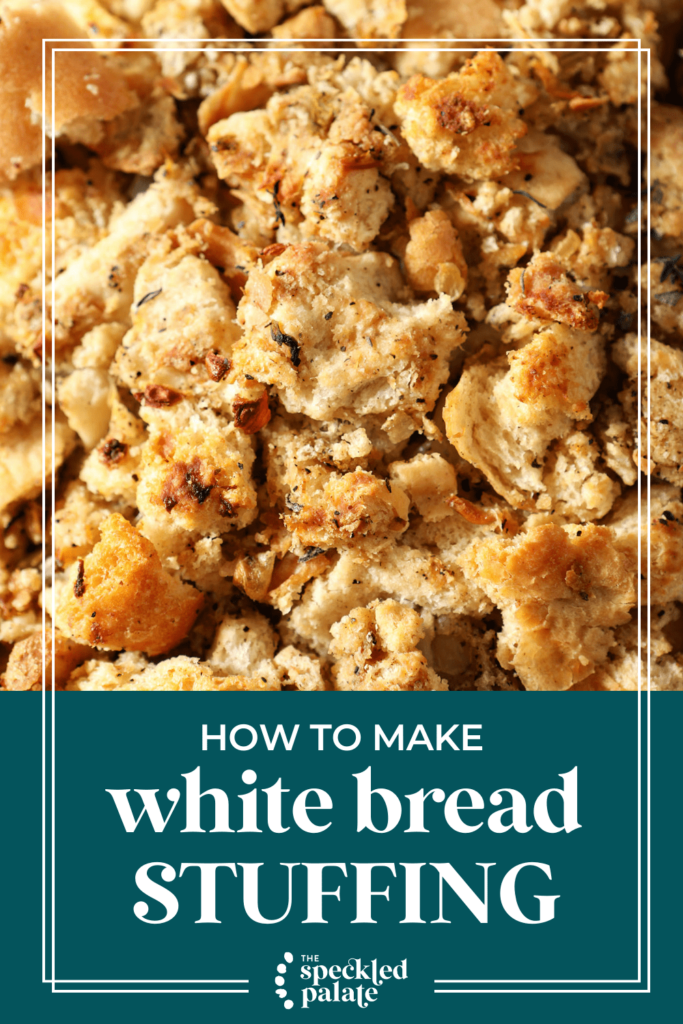
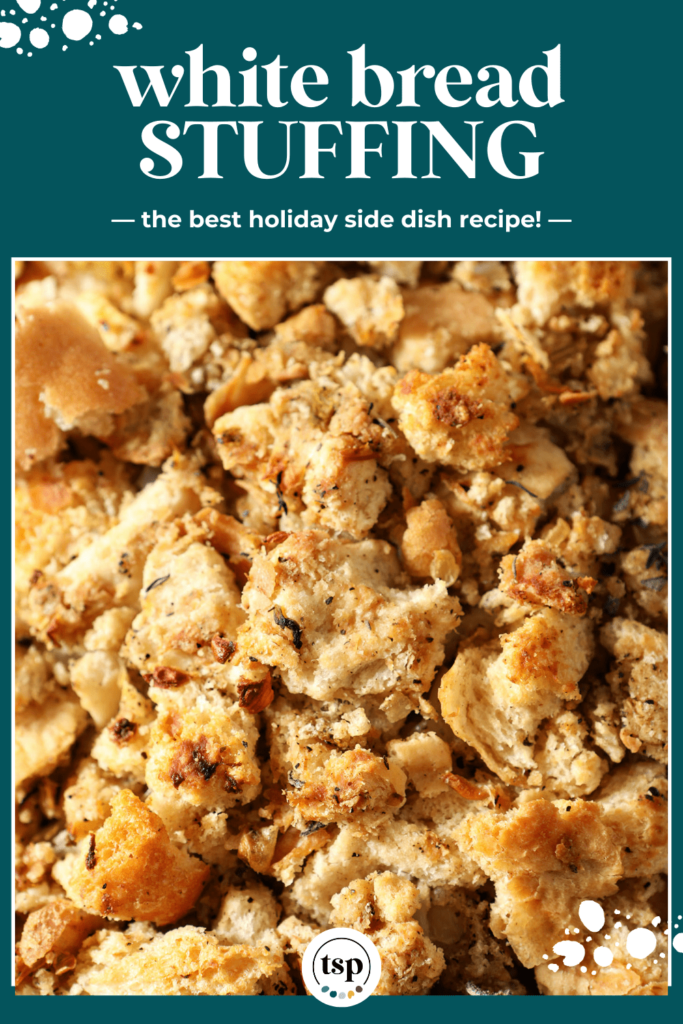
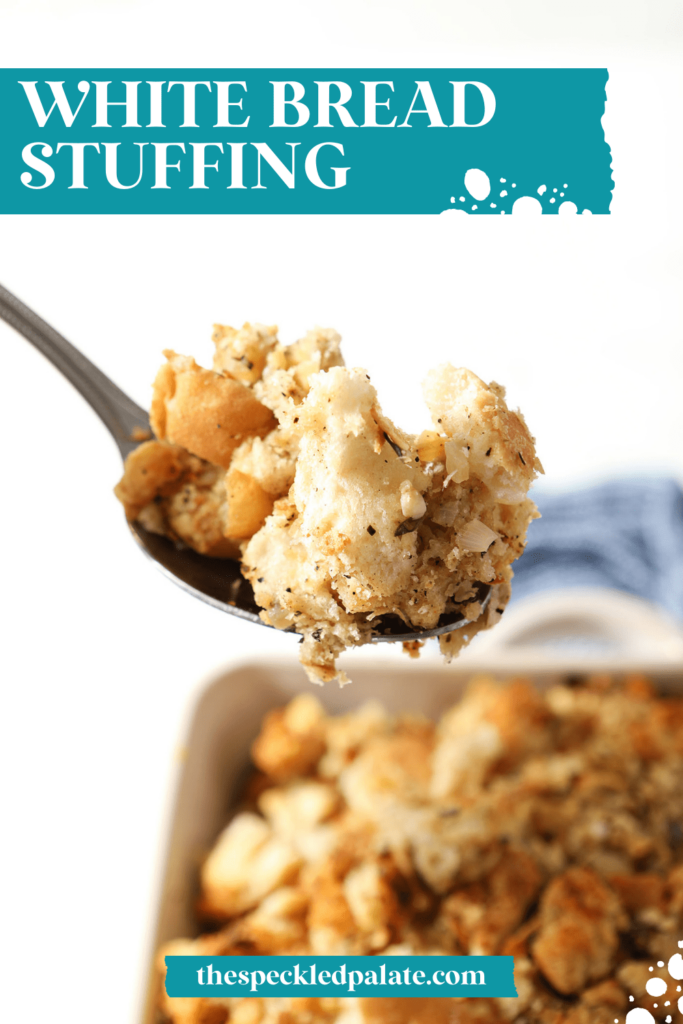
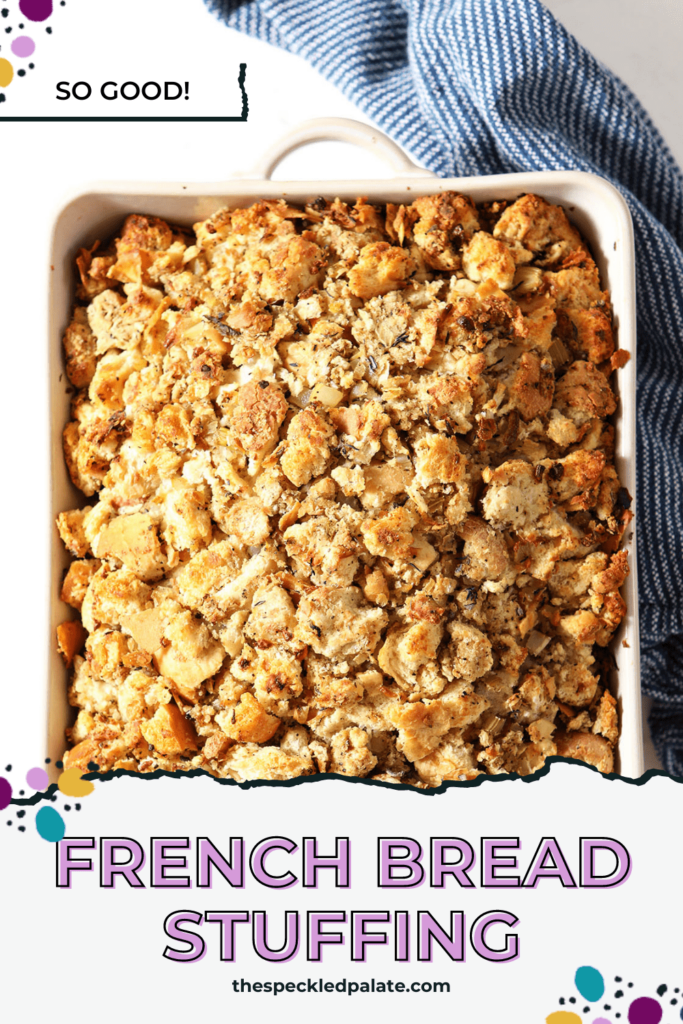
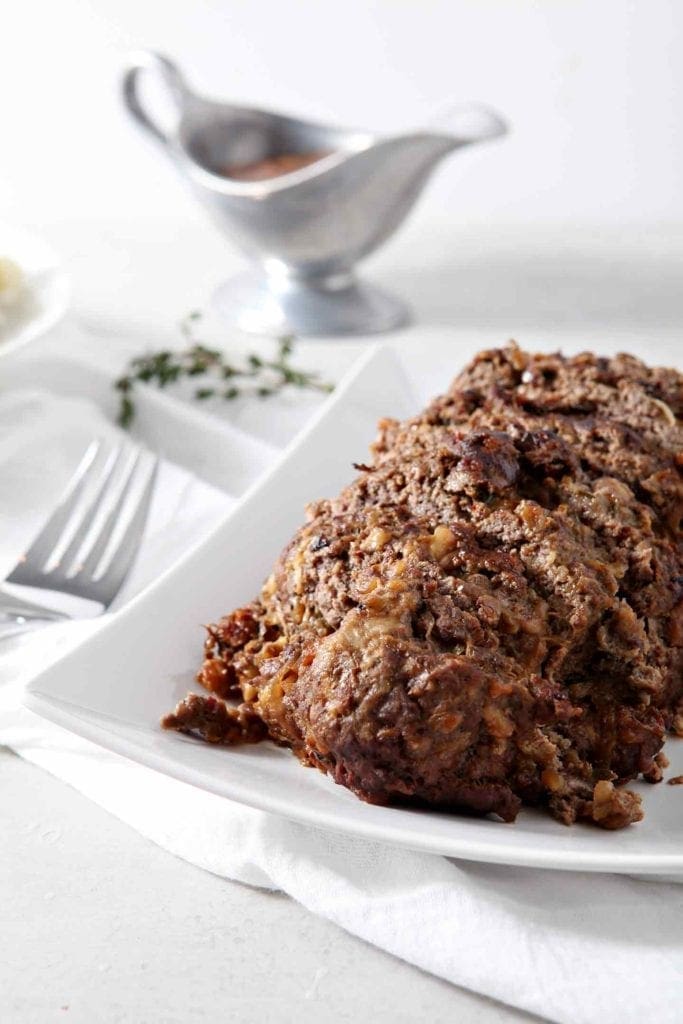
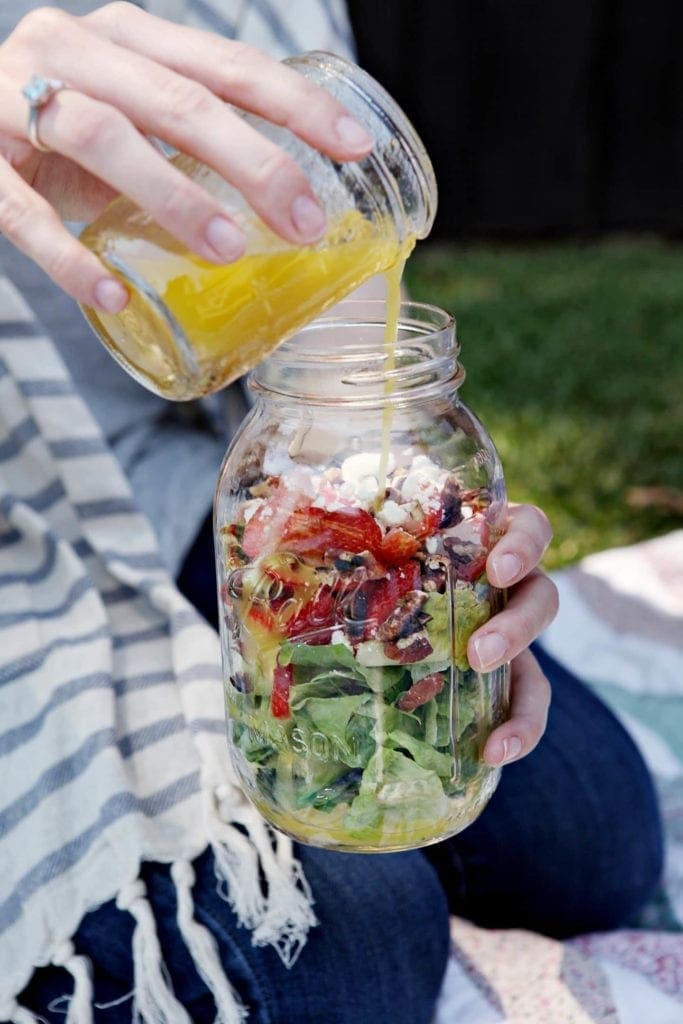
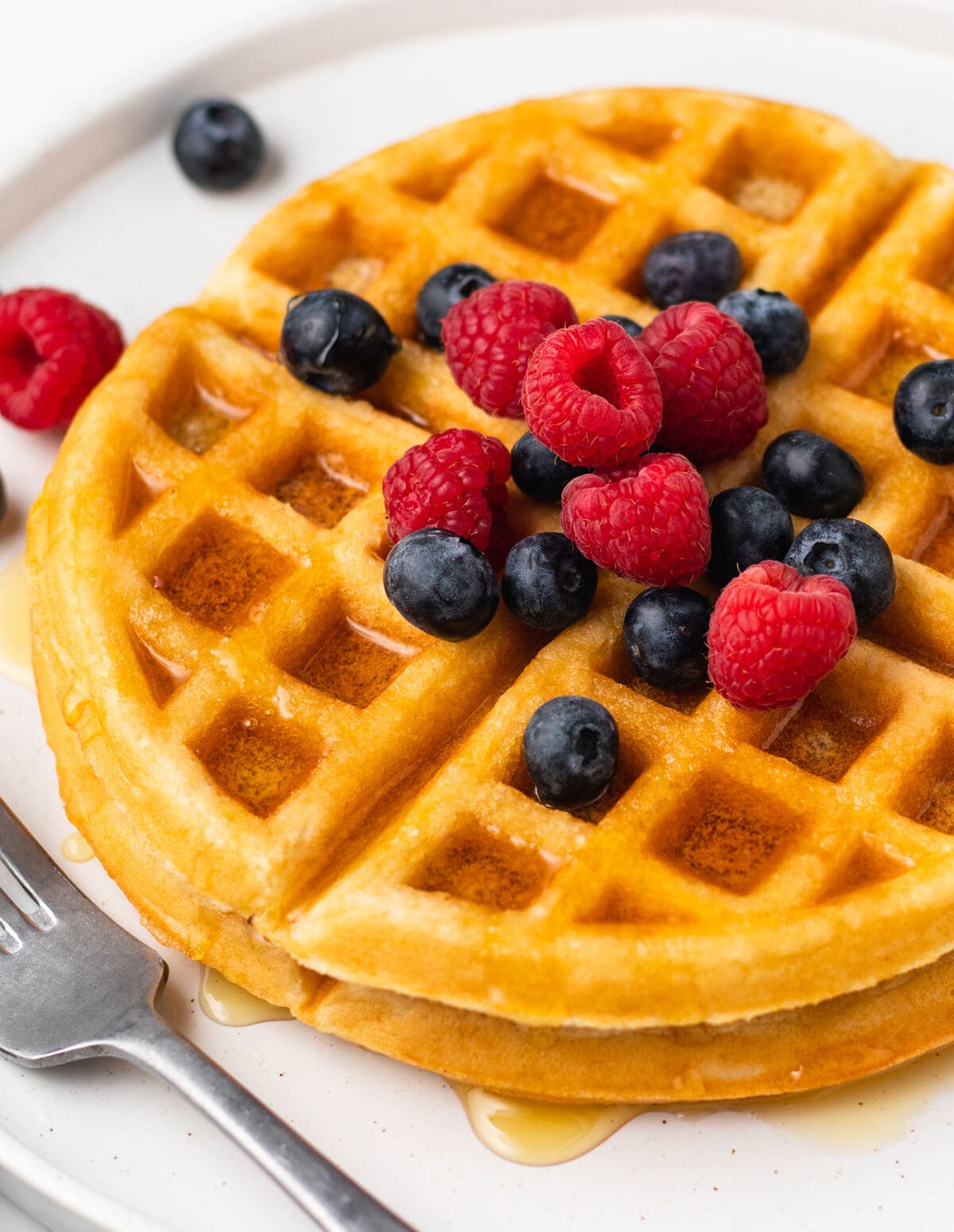
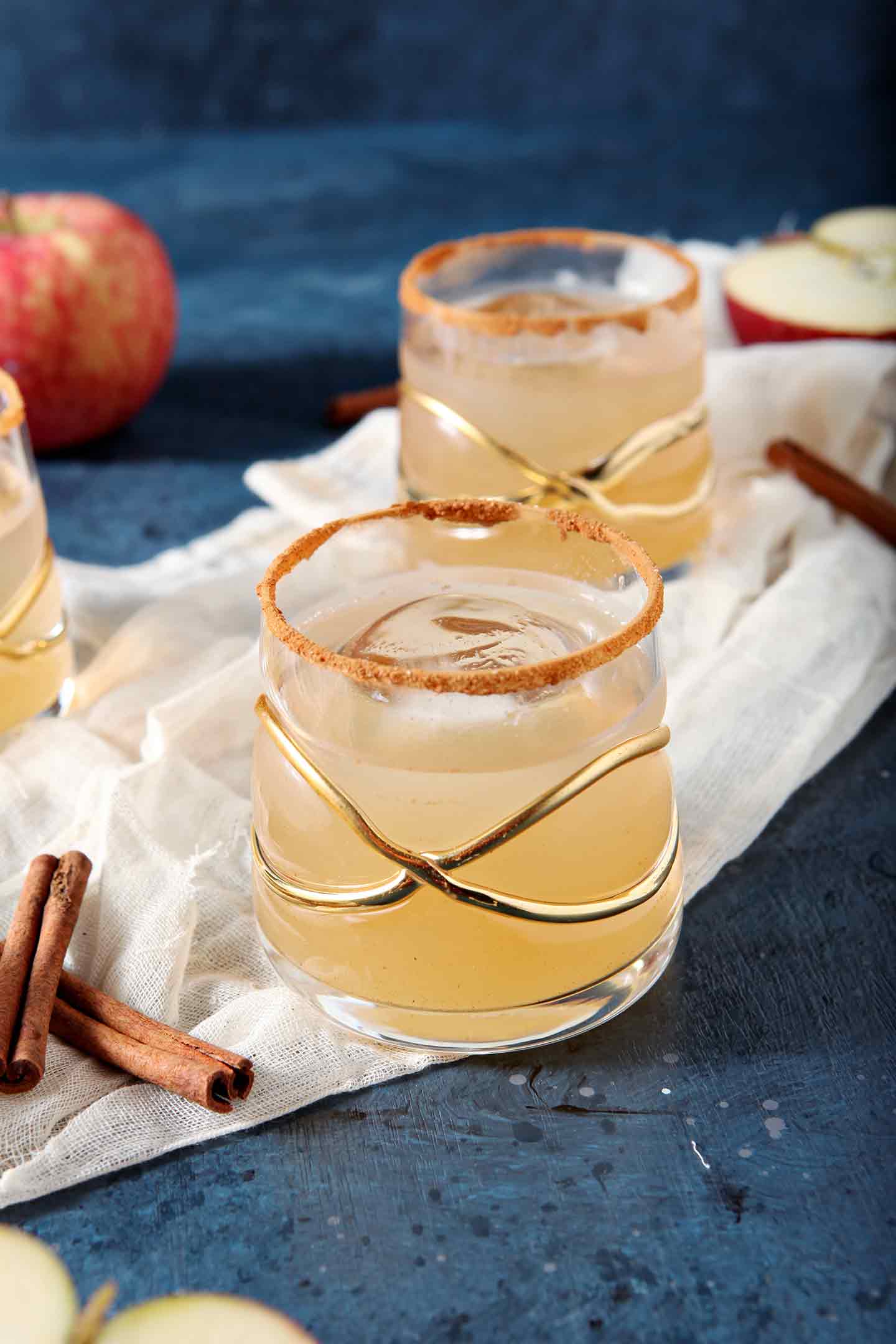
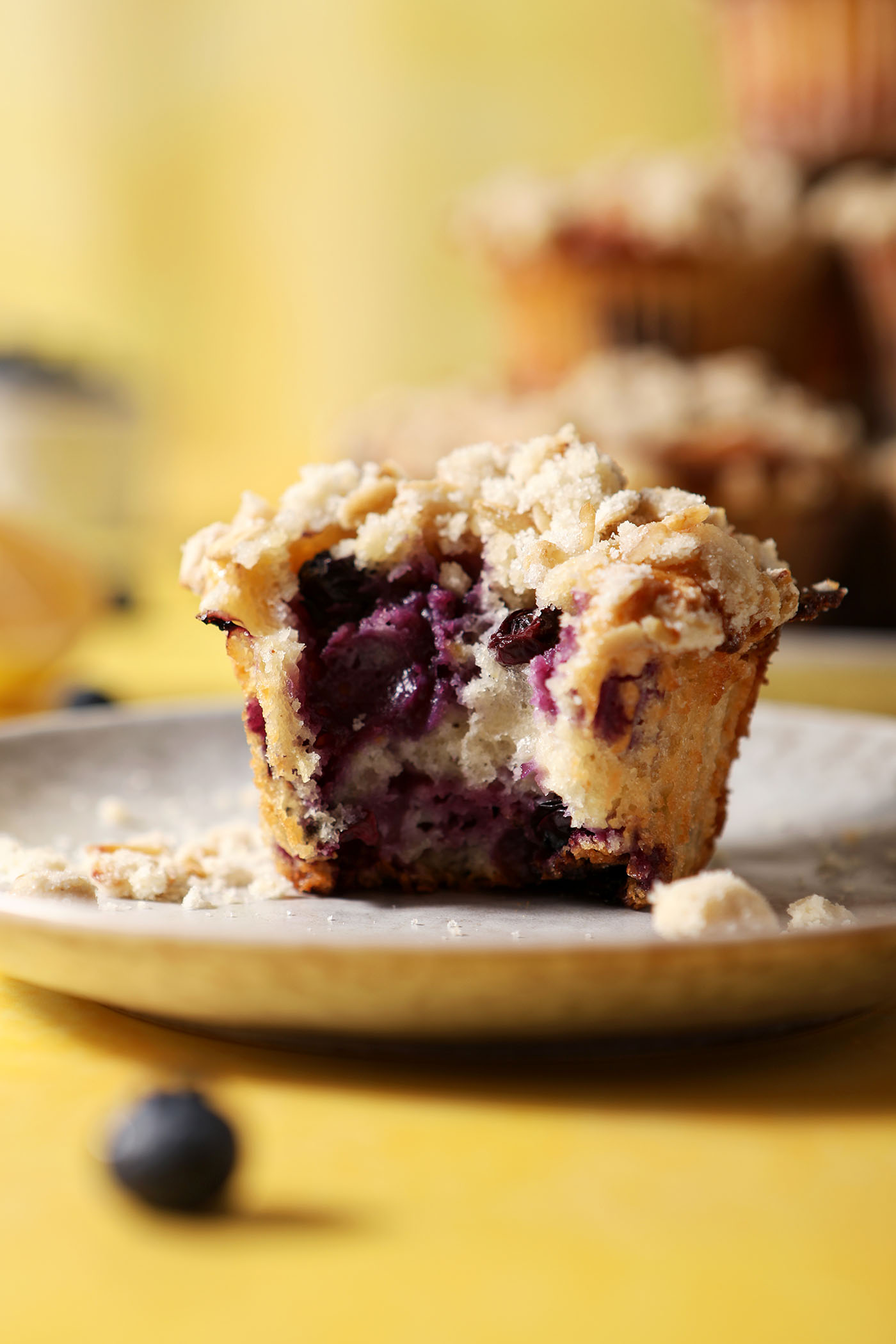
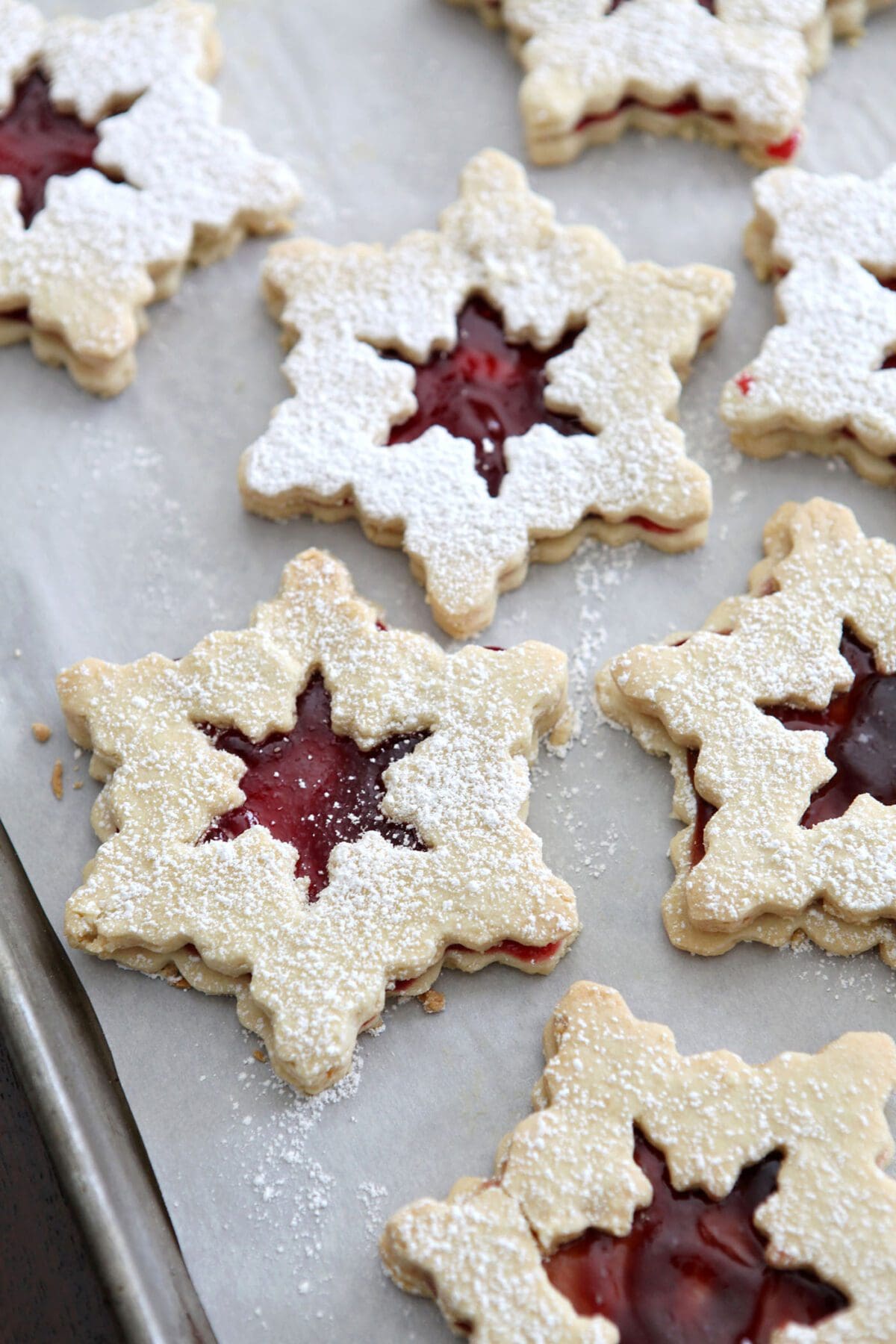
Before leaving a comment or rating, ask yourself: